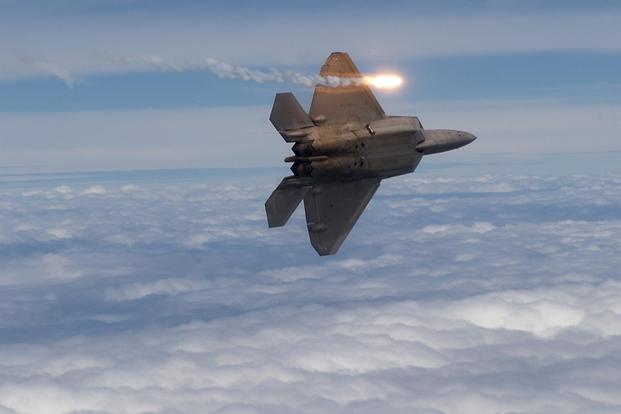Two U.S. F-22 Raptor stealth fighters intercepted two Russian Su-25 fighter jets Wednesday, conducting multiple maneuvers, firing warning flares and, in one instance, aggressively flying to avoid colliding with one another, U.S. officials tell Military.com.
The Su-25s -- single-seat, twin-engine aircraft -- "flew into coordinated coalition airspace on the east side of the Euphrates River near Abu Kamal, Syria, and were promptly intercepted," Air Forces Central Command spokesman Lt. Col. Damien Pickart told Military.com in an email.
The F-22s, the U.S.' most advanced fighter aside from the F-35 Joint Strike Fighter, were in the area providing air cover for partner ground forces conducting operations against the Islamic State, he said.
"The F-22s conducted multiple maneuvers to persuade the Su-25s to depart our deconflicted airspace, including the release of chaff and flares in close proximity to the Russian aircraft and placing multiple calls on the emergency channel to convey to the Russian pilots that they needed to depart the area," Pickart said.
During one maneuver, an Su-25 flew so close to an F-22 "that it had to aggressively maneuver to avoid a midair collision," he said.
Related content:
- General: US Pilots Made the Call to Shoot Down Syrian Aircraft
- Why the F-22 Raptor Didn't Get the Air-to-Air Kill in Syria
- Did the Air Force Dash Hopes for Building More F-22s?
- Mattis: Trump Empowered Commanders to 'Annihilate ISIS'
A Russian Su-35 multi-role fighter was also involved.
An F-22 ended up trailing the Su-35 after it flew across the river into territory deemed unsafe to coalition aircraft.
"The incident lasted approximately 40 minutes before the Russian aircraft flew to the west side of the river. During and following the encounter, coalition leaders at the [Combined Air Operations Center in Al Udeid, Qatar] contacted the Russians on the deconfliction line to de-escalate the situation and avert a strategic miscalculation," Pickart said.
AFCENT officials said the Russians had "verbally agreed" in November through the deconfliction line that they would remain west of the Euphrates River, and the coalition would operate to the East, he said.
"Since agreeing to this deconfliction arrangement, the Russians have flown into our airspace on the east side of the river 6-8 times per day, or approximately 10 percent of the Russian and Syrian flights," Pickart noted.
"If either of us needs to cross the river for any reason, we're supposed to first deconflict via the line," he said. "It's become increasingly tough for our pilots to discern whether Russian pilots' actions are deliberate or if these are just honest mistakes."
Officials have said recently that coalition aircraft -- more than a dozen air forces cooperating to defeat ISIS in Iraq and Syria -- are concerned about the shrinking airspace.
"The coalition's greatest concern is that we could shoot down a Russian aircraft because its actions are seen as a threat to our air or ground forces," Pickart said. "We train our aircrew to take specific actions and to make every attempt possible to de-escalate the situation wherever possible."
He continued, "We are not here to fight the Russians and Syrians -- our focus remains on defeating ISIS. That said, if anyone threatens coalition or friendly partner forces in the air or on the ground, we will defend them."
-- Oriana Pawlyk can be reached at oriana.pawlyk@military.com. Follow her on Twitter at @Oriana0214.













